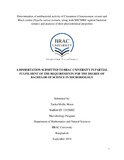| dc.description.abstract | Medicinal plants are nothing but a blessing to us as they are the ample bio-resource of drugs for traditional medicines, food supplements, modern medicines, pharmaceutical intermediates, and chemical units for synthetic drugs. In the present study, ethanol, methanol and acetonic extracts of Cinnamomum verum and Nigella sativa, were subjected to microbial susceptibility assays using agar well diffusion method. The microorganisms employed were Bacillus cereus, Bacillus subtilis, Escherichia coli, Klebsiella pneumoniae, Staphylococcus aureus, Streptococcus pyogenes, and Proteus vulgaris. Five commercial antibiotics named gentamicin; clindamycin, vancomycin, meropenem and cefepime were also used for determining the Activity Index. The minimum inhibitory concentration (MIC) and minimum bactericidal concentration (MBC) of cinnamon and Black Cumin extracts were also detected against highly susceptible organisms by using tube dilution method. Here, the highest AI value was 1.68 for methamolic extract of black cumin to vancomycin against S.aureus. After that, we also examined the phytochemical properties (tannin, saponin, flavonoids, alkaloids, phenol, steroid and starch) of cinnamon and black cumin extracts. In result, the most susceptible microorganisms were Bacillus subtilis and Staphylococcus aureus, and Bacillus cereus while the least susceptible were Escherichia coli and Klebsiella pneumoniae for both extracts. The lowest MIC value (25mg\ml) and lowest MBC value (30mg\ml) were found for methanolic extract of both cinnamon and black cumin extracts against B.subtilis and S.aureus respectively. Three extracts of cinnamon showed positive result for saponin, alkaloid and steroid. On the other hand, all extracts of black cumin showed positive result for alkaloid, steroid and negative result for tannin and saponin. In short, the findings of this study may provide the possibility of developing antibacterial supplements from these medicinal plants. | en_US |

